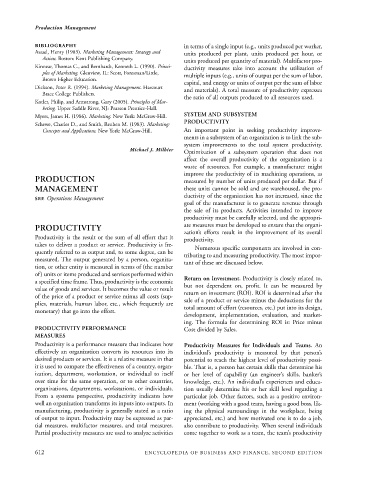Page 635 - Encyclopedia of Business and Finance
P. 635
eobf_P 7/5/06 3:18 PM Page 612
Production Management
BIBLIOGRAPHY in terms of a single input (e.g., units produced per worker,
Assael, Henry (1985). Marketing Management: Strategy and units produced per plant, units produced per hour, or
Action. Boston: Kent Publishing Company.
units produced per quantity of material). Multifactor pro-
Kinnear, Thomas C., and Bernhardt, Kenneth L. (1990). Princi- ductivity measures take into account the utilization of
ples of Marketing. Glenview, IL: Scott, Foresman/Little, multiple inputs (e.g., units of output per the sum of labor,
Brown Higher Education.
capital, and energy or units of output per the sum of labor
Dickson, Peter R. (1994). Marketing Management. Harcourt and materials). A total measure of productivity expresses
Brace College Publishers.
the ratio of all outputs produced to all resources used.
Kotler, Philip, and Armstrong, Gary (2005). Principles of Mar-
keting. Upper Saddle River, NJ: Pearson Prentice-Hall.
Myers, James H. (1986). Marketing. New York: McGraw-Hill. SYSTEM AND SUBSYSTEM
PRODUCTIVITY
Schewe, Charles D., and Smith, Reuben M. (1983). Marketing:
Concepts and Applications. New York: McGraw-Hill. An important point in seeking productivity improve-
ments in a subsystem of an organization is to link the sub-
system improvements to the total system productivity.
Michael J. Milbier Optimization of a subsystem operation that does not
affect the overall productivity of the organization is a
waste of resources. For example, a manufacturer might
improve the productivity of its machining operations, as
PRODUCTION measured by number of units produced per dollar. But if
MANAGEMENT these units cannot be sold and are warehoused, the pro-
ductivity of the organization has not increased, since the
SEE Operations Management
goal of the manufacturer is to generate revenue through
the sale of its products. Activities intended to improve
productivity must be carefully selected, and the appropri-
PRODUCTIVITY ate measures must be developed to ensure that the organi-
zation’s efforts result in the improvement of its overall
Productivity is the result or the sum of all effort that it productivity.
takes to deliver a product or service. Productivity is fre-
Numerous specific components are involved in con-
quently referred to as output and, to some degree, can be
tributing to and measuring productivity. The most impor-
measured. The output generated by a person, organiza-
tant of these are discussed below.
tion, or other entity is measured in terms of (the number
of) units or items produced and services performed within
a specified time frame. Thus, productivity is the economic Return on Investment. Productivity is closely related to,
value of goods and services. It becomes the value or result but not dependent on, profit. It can be measured by
return on investment (ROI). ROI is determined after the
of the price of a product or service minus all costs (sup- sale of a product or service minus the deductions for the
plies, materials, human labor, etc., which frequently are total amount of effort (resources, etc.) put into its design,
monetary) that go into the effort.
development, implementation, evaluation, and market-
ing. The formula for determining ROI is: Price minus
PRODUCTIVITY PERFORMANCE Cost divided by Sales.
MEASURES
Productivity is a performance measure that indicates how Productivity Measures for Individuals and Teams. An
effectively an organization converts its resources into its individual’s productivity is measured by that person’s
desired products or services. It is a relative measure in that potential to reach the highest level of productivity possi-
it is used to compare the effectiveness of a country, organ- ble. That is, a person has certain skills that determine his
ization, department, workstation, or individual to itself or her level of capability (an engineer’s skills, banker’s
over time for the same operation, or to other countries, knowledge, etc.). An individual’s experiences and educa-
organizations, departments, workstations, or individuals. tion usually determine his or her skill level regarding a
From a systems perspective, productivity indicates how particular job. Other factors, such as a positive environ-
well an organization transforms its inputs into outputs. In ment (working with a good team, having a good boss, lik-
manufacturing, productivity is generally stated as a ratio ing the physical surroundings in the workplace, being
of output to input. Productivity may be expressed as par- appreciated, etc.) and how motivated one is to do a job,
tial measures, multifactor measures, and total measures. also contribute to productivity. When several individuals
Partial productivity measures are used to analyze activities come together to work as a team, the team’s productivity
612 ENCYCLOPEDIA OF BUSINESS AND FINANCE, SECOND EDITION

